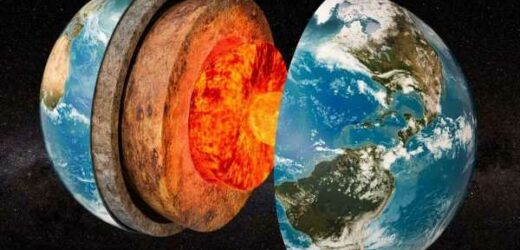Scientists have identified a previously unknown layer of partially molten rock hidden below the Earth’s crust — one that may help settle a long-standing puzzle about how tectonic plates move. The molten layer, researchers led from the University of Texas at Austin explained, sits at a depth of around 100 miles beneath the surface and is part of the so-called asthenosphere, the mechanically weak and deformable part of the upper mantle. The asthenosphere is important for continental drift, as it forms a relatively soft boundary that allows the base of tectonic plates to move through the mantle.
The reason why the asthenosphere is soft, however, is not well-understood.
Previous studies had identified patches of melt at 100 miles deep — but the new study is the first to reveal that these belong to a layer that is found around most of the globe.
According to Dr Hua, the idea to look for a new layer within the Earth came when he was studying images of the mantle beneath Turkey — formed by the passage of seismic waves — during his doctoral studies.
Intrigued by signs of partially molten rock under the crust in these images, he began to compile similar data from around the world, until he had put together essentially a global map of the asthenosphere.

We use your sign-up to provide content in ways you’ve consented to and to improve our understanding of you. This may include adverts from us and 3rd parties based on our understanding. You can unsubscribe at any time. More info

This “map” revealed that such molten rock was commonplace, encompassing almost half of the Earth and appearing on the seismic readings wherever the asthenosphere was hottest — and not, as had been previously assumed, just a series of localised anomalies.
It had previously been suggested the presence of molten rock in the asthenosphere might account for its “softness”.
However, the researchers found, the presence of the melt layer doesn’t actually appear to have a significant influence on the flow of mantle rocks.
Specifically, when Dr Hua compared his map of melt in the asthenosphere with seismic measurements of tectonic movement, he found no correlation.


Paper author and seismologist Dr Junlin Hua said: “When we think about something melting, we intuitively think that the melt must play a big role in the material’s viscosity.
“But what we found is that even where the melt fraction is quite high, its effect on mantle flow is very minor.”
Instead, Dr Hua and colleagues found, the principal influence on the motion of Earth’s tectonic plates appears instead to be the convention of heat and rock in the mantle. While the Earth’s mantle is largely solid, on long timescales it can flow like treacle.
Demonstrating that the newly-identified melt layer has no influence on plate tectonics means one less thing to worry about when creating models of the Earth, the team said.
DON’T MISS;
Sturgeon humiliated as Scotland missed ‘£60bn surge from energy deal’ [ANALYSIS]
Britons being overcharged hundreds of pounds in energy costs [REPORT]
This man has a plan to save the NHS — but he needs your help [INSIGHT]

Paper co-author and geodynamicist Professor Thorsten Becker commented: “We can’t rule out that, locally, melt doesn’t matter.
“But I think it drives us to see these observations of melt as a marker of what’s going on in the Earth, and not necessarily an active contribution to anything.”
Seismologist and fellow co-author Professor Karen Fischer of Brown University concluded: “This work is important because understanding the properties of the asthenosphere and the origins of why it is weak is fundamental to understanding plate tectonics.”
The full findings of the study were published in the journal Nature Geoscience.
Source: Read Full Article


